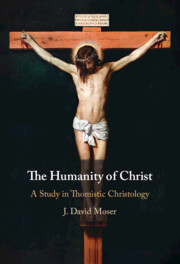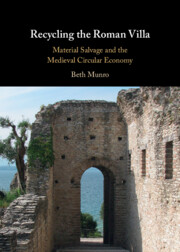Refine search
Actions for selected content:
396 results
2 - St. John Damascene, St. Maximus the Confessor, and the Earlier Greek Fathers on the Instrument Doctrine
- from Part I - Foundations and Statements of the Doctrine
-
- Book:
- The Humanity of Christ as Instrument of Salvation
- Published online:
- 21 August 2025
- Print publication:
- 04 September 2025, pp 31-65
-
- Chapter
- Export citation

The Humanity of Christ as Instrument of Salvation
- A Study in Thomistic Christology
-
- Published online:
- 21 August 2025
- Print publication:
- 04 September 2025
20 - Metalwork
- from Part II - Artefacts and Evidence
-
- Book:
- The Cambridge Encyclopaedia of Late Antique Art and Archaeology
- Published online:
- 04 July 2025
- Print publication:
- 31 July 2025, pp 374-397
-
- Chapter
- Export citation
Effect of supplementation with vitamin D on biochemical markers of iron status and erythropoiesis in older people: BEST-D trial
-
- Journal:
- British Journal of Nutrition / Volume 134 / Issue 1 / 14 July 2025
- Published online by Cambridge University Press:
- 02 June 2025, pp. 28-34
- Print publication:
- 14 July 2025
-
- Article
-
- You have access
- Open access
- HTML
- Export citation
A systematic review of zinc, iron and vitamin B12 content of edible insects and comparison with dietary reference values
-
- Journal:
- Nutrition Research Reviews , First View
- Published online by Cambridge University Press:
- 27 March 2025, pp. 1-17
-
- Article
-
- You have access
- Open access
- HTML
- Export citation
Nutrient intake variability and number of days needed to estimate usual intake in children and adolescents with autism spectrum disorder
-
- Journal:
- British Journal of Nutrition / Volume 133 / Issue 6 / 28 March 2025
- Published online by Cambridge University Press:
- 28 February 2025, pp. 845-854
- Print publication:
- 28 March 2025
-
- Article
- Export citation
Dietary iron interacts with diet composition to modulate the endocannabinoidome and the gut microbiome in mice
-
- Journal:
- Gut Microbiome / Volume 6 / 2025
- Published online by Cambridge University Press:
- 14 February 2025, e12
-
- Article
-
- You have access
- Open access
- HTML
- Export citation
4.7 - The New Person
- from History 4 - Heroes
-
-
- Book:
- The New Cambridge History of Russian Literature
- Published online:
- 31 December 2024
- Print publication:
- 12 December 2024, pp 788-805
-
- Chapter
- Export citation

Recycling the Roman Villa
- Material Salvage and the Medieval Circular Economy
-
- Published online:
- 08 November 2024
- Print publication:
- 31 October 2024
The concentration of hemoglobin is associated with the dietary iron availability, food insecurity and the use of oral contraceptives among women in socially vulnerable areas of a capital city in northeastern Brazil
-
- Journal:
- British Journal of Nutrition / Volume 132 / Issue 7 / 14 October 2024
- Published online by Cambridge University Press:
- 17 October 2024, pp. 946-955
- Print publication:
- 14 October 2024
-
- Article
-
- You have access
- HTML
- Export citation
The Influence of Aluminum on Iron Oxides. VII. Substitution of Al for Fe in Synthetic Lepidocrocite
-
- Journal:
- Clays and Clay Minerals / Volume 28 / Issue 4 / August 1980
- Published online by Cambridge University Press:
- 01 July 2024, pp. 267-271
-
- Article
- Export citation
Dehydroxylation of Dioctahedral Phyllosilicates
-
- Journal:
- Clays and Clay Minerals / Volume 28 / Issue 5 / October 1980
- Published online by Cambridge University Press:
- 01 July 2024, pp. 355-368
-
- Article
- Export citation
Hydrothermal Vermiculite from the Atlantis II Deep, Red Sea
-
- Journal:
- Clays and Clay Minerals / Volume 29 / Issue 6 / December 1981
- Published online by Cambridge University Press:
- 01 July 2024, pp. 454-458
-
- Article
- Export citation
The Influence of Aluminum on Iron Oxides. Part II. Preparation and Properties of Al-Substituted Hematites
-
- Journal:
- Clays and Clay Minerals / Volume 27 / Issue 2 / April 1979
- Published online by Cambridge University Press:
- 01 July 2024, pp. 105-112
-
- Article
- Export citation
Spectroscopic Investigations of Iron Distribution in Some Bentonites from Sardinia
-
- Journal:
- Clays and Clay Minerals / Volume 28 / Issue 3 / June 1980
- Published online by Cambridge University Press:
- 01 July 2024, pp. 233-236
-
- Article
- Export citation
Application of Electron Paramagnetic Resonance and Mössbauer Spectroscopy in the Investigation of Kaolinite-Group Minerals
-
- Journal:
- Clays and Clay Minerals / Volume 29 / Issue 1 / February 1981
- Published online by Cambridge University Press:
- 01 July 2024, pp. 23-30
-
- Article
- Export citation
Mössbauer Studies of Palygorskite and Some Aspects of Palygorskite Mineralogy
-
- Journal:
- Clays and Clay Minerals / Volume 29 / Issue 3 / June 1981
- Published online by Cambridge University Press:
- 01 July 2024, pp. 226-232
-
- Article
- Export citation
The Mössbauer Spectra of Nontronites: Consideration of an Alternative Assignment
-
- Journal:
- Clays and Clay Minerals / Volume 26 / Issue 2 / April 1978
- Published online by Cambridge University Press:
- 01 July 2024, pp. 176-177
-
- Article
- Export citation
Electron Spin Resonance Studies of Iron Oxides Associated with the Surface of Kaolins
-
- Journal:
- Clays and Clay Minerals / Volume 26 / Issue 4 / August 1978
- Published online by Cambridge University Press:
- 01 July 2024, pp. 263-272
-
- Article
- Export citation
Synthesis of Iron Layer Silicate Minerals under Natural Conditions
-
- Journal:
- Clays and Clay Minerals / Volume 26 / Issue 1 / February 1978
- Published online by Cambridge University Press:
- 01 July 2024, pp. 65-72
-
- Article
- Export citation
